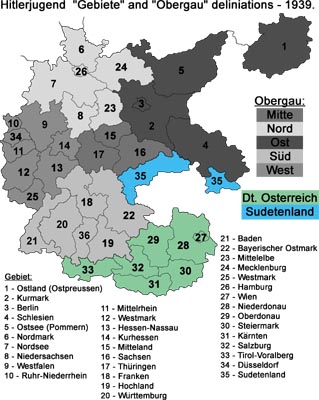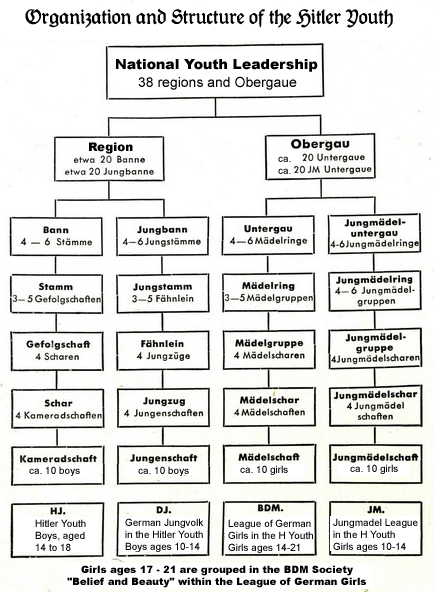Obergaue and Gaue
The organizational structure of the Hitler Youth was brought in line with that of the SA, which was its original parent organization, in 1931. Within the SA, the Gruppewas the largest known formation at that time. The Hitler Youth was now an official nationwide organization and also had some groups outside the borders of Germany, particularly in Austria and the free city of Danzig.
In 1933, the existing structure was changed to add a higher regional area called the Obergebiet, and five of these were set up: East, Middle, West, South, and North. Each of these was divided into a number of Gebiete. By 1937, the area was made up of twenty- seven of those:
East
Berlin
Kurmark (Brandenburg)
Pommern (Pommerania)
Schlesien (Silesia)
Ostland (Danzig and East Prussia)
Middle
Thueringen (Thuringia)
Sachsen (Saxony)
Mittelelbe (Central Elbe)
Mittelland (Midlands)
West
Kurhessen (Grand Hesse)
Hessen-Nassau
Mittelrhein (Central Rhine)
Ruhr-Niederrhein (Ruhr and Lower Rhine)
Westmark
Saarpfalz (Saar and Palatinate)
Westfalen (Westphalia)
South
Franken (Franconia)
Baden
Wuerttemberg
Hochland (Central Bavaria)
Bayrische Ostmark (Eastern Bavaria)
Westfalen (Westphalia)
North
Ostsee (Baltic Sea)
Nordmark (Schleswig-Holstein)
Hamburg
Nordsee (North Sea)
Mecklenburg
Niedersachsen (Lower Saxony)
By 1939, there were thirty five Gaue which can be seen on the map below, which is copyright to Arvo Vercamer and part of his excellent research on the Hitler Youth, some of which can be found at this website.

Unit Structure
To simplify the organizational table below for English-speaking research, I’ve attempted to include approximate translations of the German terms and titles as well as the average number of girls in each group or section. The highest level is at the top, and the smallest grouping within the League of German Girls is at the bottom.
→ Reichsjugendfuehrung
The national youth leadership staff, which was headed by the overall youth leader Baldur von Schirach and later his successor Artur Axmann, had its offices in Berlin and oversaw all youth work in the Third Reich. The head of the League of German Girls was the national speaker, the BDM Reichsreferentin. The first national speaker was Trude Buerkner-Mohr, who was succeeded by Dr. Jutta Ruediger in 1937, who held the post until the end of the war.
→ Gauverband
The BDM Gauverband, or regional grouping, consisted of five Obergaue and encompassed between 375,000 and 400,000 girls, depending on the individual regions’ size.
→ Obergau
The Obergau, or region, was a grouping of five districts of BDM girls (which equals approximately 20 Untergaue) and comprised about 75,000 girls.
→ Gau
A Gau, or district, included five lower districts, and had a membership of about 15,000 BDM girls.
→ Untergau
An Untergau – a lower district, or sub-district – was made up of five regional circles, or about 3,000 girls. Please note that the nomenclature of Untergau and all of the regions above Untergau, remain the same for both the League of German Girls and the Jungmaedel.
→ Maedel Ring (Jungmaedel Ring)
Literally the “girls circle” (or young girls’ circle), although it is more accurately translated to township group. This small regional grouping was made up of four to six girls groups for the Jungmaedel, or three to five girls groups of the League of German Girls, and included between 600 and 800 members. Please note that when the word “circle” is used in German translations referring to regions, it should be thought of a township with a larger central town and the outlying smaller towns and villages around it.
→ Maedel Gruppe (or Jungmaedel Gruppe)
The smallest of the regional groupings was the Girls Group (or Jungmaedel Group) in a town of village. Each of these included four troops or around 160 members total.
→ Maedel Schar (or Jungmaedel Schar)
Schar is best translated as an equivalent of a modern-day girl scout troop. Each troop is made up of four squads (or girl scout dens) and includes around 40 girls.
→ Maedelschaft (or Jungmaedelschaft)
A Maedelschaft, which is the smallest unit within the BDM, can be thought of along the terms of a girl scout den, and included around 10 girls.
BDM – Bund Deutscher Mädchen (League of German Girls 14 to 18)
Smallest to Biggest Units
- Mädelschaft was the smallest unit with 10 to 15 girls.
- Mädelschar consisted of 3 or 4 Mädelschaften totaling 50-60.
- Mädelgruppe consisted of 3 or 4 Maedelscharen totaling 150-190.
- Mädelring consisted of 4 to 6 Gefolgschaften totaling 600-800.
- Untergau consisted of 5 Mädelring totaling 3,000.
- Gau consisted of 5 Untergaue totaling 15,000.
- Obergau consisted of 5 Gaue totaling 75,000.
- Gauverband consisted of 5 Obergaue totaling 375,000.
BDM Ranks
lowest to highest
(Girls 14 to 18)
- Mädel
- Mädelschaftsführerin
- Mädelscharfürerin
- Mädelgruppenführerin
- Mädelringführerin
- Untergauführerin
- Hauptmädelführerin
- Obergauführerin
- Reichsreferentin
Deutsche Jungmädel Ranks
lowest to highest
(Girls 10 to 14)
- Jungmädel
- Jungmädelschaftsführerin
- JM-Scharführerin
- JM-Gruppenführerin
- JM-Ringführerin
- JM-Untergauführerin
Pre-war Membership
1923
1924
1925
1926
1927
1928
1929
1930
1931
1932
1933
1934
1935
1936
1937
1938
1939
HJ DJV BDM DJM Combined
1,200
2,400
5,000
6,000
8,000
10,000
13,000
26,000
63,700
99,586
2,292,041
3,577,565
3,942,303
5,437,602
5,879,955
7,031,226
7,287,470



